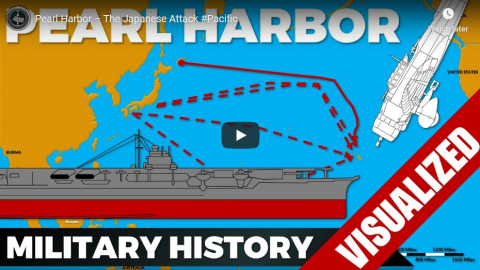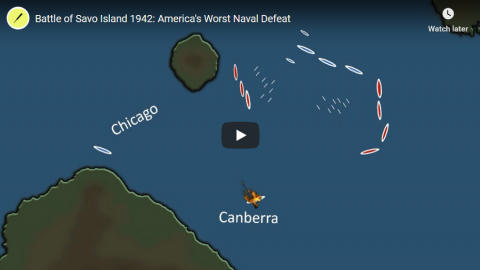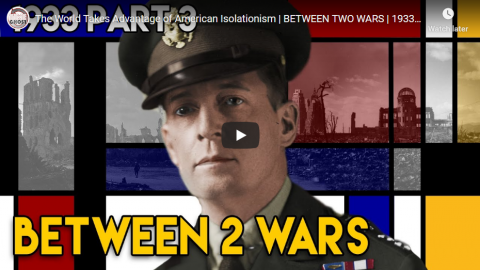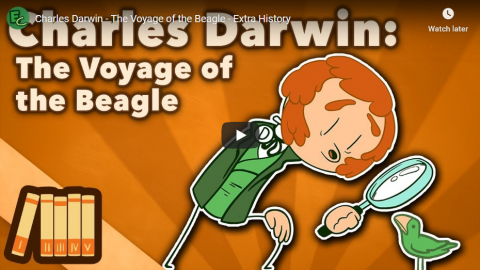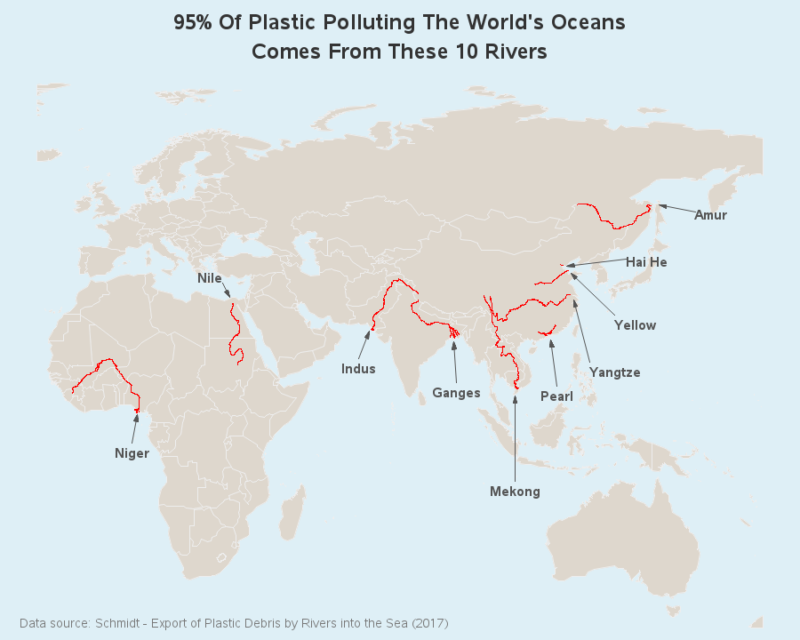Forgotten Weapons
Published 30 Dec 2019Corporal Tony Stein
United States Marine Corps ReserveFor conspicuous gallantry and intrepidity at the risk of his life above and beyond the call of duty while serving with Company A, First Battalion, Twenty-Eighth Marines, Fifth Marine Division, in action against enemy Japanese forces on Iwo Jima, in the Volcano Island, 19 February 1945. The first man of his unit to be on station after hitting the beach in the initial assault, Corporal Stein, armed with a personally improvised aircraft-type weapon, provided rapid covering fire as the remainder of his platoon attempted to move into position and, when his comrades were stalled by a concentrated machine-gun and mortar barrage, gallantly stood upright and exposed himself to the enemy’s view, thereby drawing the hostile fire to his own person and enabling him to observe the location of the furiously blazing hostile guns. Determined to neutralize the strategically placed weapons, he boldly charged the enemy pillboxes one by one and succeeded in killing twenty of the enemy during the furious single-handed assault. Cool and courageous under the merciless hail of exploding shells and bullets which fell on all sides, he continued to deliver the fire of his skillfully improvised weapon at a tremendous rate of speed which rapidly exhausted his ammunition. Undaunted, he removed his helmet and shoes to expedite his movements an ran back to the beach for additional ammunition, making a total of eight trips under intense fire and carrying or assisting a wounded man back each time. Despite the unrelenting savagery and confusion of battle, he rendered prompt assistance to his platoon whenever the unit was in position, directing the fire of a half-track against a stubborn pillbox until he had effected the ultimate destruction of the Japanese fortification. Later in the day, although his weapon was twice shot from his hands, he personally covered the withdrawal of his platoon to the company position. Stouthearted and indomitable, Corporal Stein, by his aggressive initiative, sound judgment and unwavering devotion to duty in the face of terrific odds, contributed materially to the fulfillment of his mission, and his outstanding valor throughout the bitter hours of conflict sustained and enhanced the highest traditions of the United States Naval Service.
Harry S. Truman
President of the United StatesThe Stinger was a Browning aircraft machine gun adapted to use an M1 Garand buttstock and BAR bipod, used as a light machine gun by the US Marine Corps during the invasion of Iwo Jima in 1945. The gun was the creation of Sergeant Mel J Grevich oof the 5th Marine Division. Six were built and used on the attack on Iwo, including one by Corporal Tony Stein, whose outstanding bravery is documented in the Medal of Honor citation above. None of the original guns survive today, but I have the privilege of showing you this reproduction created by the Canadian Historical Arms Museum with the assistance of O’Dell Engineering.
http://www.patreon.com/ForgottenWeapons
Cool Forgotten Weapons merch! http://shop.bbtv.com/collections/forg…
Contact:
Forgotten Weapons
6281 N. Oracle #36270
Tucson, AZ 85704
December 31, 2019
USMC Stinger Machine Gun: Medal of Honor on Iwo Jima
December 7, 2019
Pearl Harbor – The Japanese Attack
Military History Visualized
Published 29 Nov 2016» HOW YOU CAN SUPPORT MILITARY HISTORY VISUALIZED «
(A) You can support my channel on Patreon: https://www.patreon.com/mhv(B) Alternatively, you can also buy “Spoils of War” (merchandise) in my online shop: https://www.redbubble.com/people/mhvi…
(C) If you want to buy books that I use or recommend, here is the link to the Amazon Store: http://astore.amazon.com/ytmh-20 which has the same price for you and gives a small commission to me, thus it is a win/win.
» SOURCES & LINKS «
Kuehn, John T.: “The war in the Pacific, 1941-1945”; in: Cambridge History of the Second World War, Volume 1
Amazon.com (affiliate): http://amzn.to/2g82o9aDull, Paul S.: The Battle History of the Imperial Japanese Navy.
Amazon.com (affiliate): http://amzn.to/2gPBxhJGermany & The Second World War – Volume VI
Amazon.com (affiliate): http://amzn.to/2g85hqtDas Deutsche Reich und der Zweite Weltkrieg, Band 6.
Amazon.de (affiliate) http://amzn.to/2gc49RaZimm, Alan D. The Pearl Harbor Myth
http://www.historynet.com/pearl-harborZimm, Alan D. Attack on Pearl Harbor: Strategy, Combat, Myths, Deceptions.
Amazon.com (affiliate): http://amzn.to/2gc0LWk» ADDITIONAL LINKS «
Maps
http://pacificwarbirds.com/pearl-harb…https://spotlights.fold3.com/2011/12/…
Verifying the Submarine loss
https://www.history.navy.mil/research…http://www.combinedfleet.com/I-70.htm
Bonus Link (not used): Original Damage Reports
https://archive.org/download/WorldWar…» CREDITS & SPECIAL THX «
Song: Ethan Meixsell – “Demilitarized Zone”» DISCLAIMER «
Amazon Associates Program: “Bernhard Kast is a participant in the Amazon Services LLC Associates Program, an affiliate advertising program designed to provide a means for sites to earn advertising fees by advertising and linking to amazon.com.”Bernhard Kast ist Teilnehmer des Partnerprogramms von Amazon Europe S.à.r.l. und Partner des Werbeprogramms, das zur Bereitstellung eines Mediums für Websites konzipiert wurde, mittels dessen durch die Platzierung von Werbeanzeigen und Links zu amazon.de Werbekostenerstattung verdient werden können.
November 22, 2019
Battle of Savo Island 1942: America’s Worst Naval Defeat
Montemayor
Published 26 Aug 2017(Animated Map) – WARNING: lower the volume if you are using headphones. sorry for the audio.
I do not own the rights to the songs or images. This video is purely for educational purposes.
No copyright intended, all image rights go to:
-Wikipedia Commons
https://commons.wikimedia.org/wiki/Ba…-Naval History Heritage and Command
https://www.history.navy.mil/-Portrait of Richmond K. Turner
https://www.ibiblio.org/hyperwar/Onli…–USS Jarvis
http://www.navsource.org/Images contained on this site that are donated from private sources are © copyrighted by the respective owner. Images credited to the National Archives (NA, NARA); Naval History & Heritage Command (NHHC), formerly Naval Historical Center (NHC); and U.S. Navy (USN) are believed to be in the public domain. Some images credited to the United States Naval Institute (USNI) are from © copyrighted collections, the rest are believed to be in the public domain.
All songs by Ross Budgen https://www.youtube.com/channel/UCQKG…
-“Welcome to Chaos”
-“House Lannister Theme” – Game of Thrones Season 4 (Original composition)
-“Run”
-“Parallel”Sources-
Hammel, E. (2017, March 6). “First Battle of Savo Island: The U.S. Navy’s Worst Defeat”. Retrieved August 25, 2017, from http://warfarehistorynetwork.com/dail…
Hornfischer, J. D. (2011). Neptunes Inferno: the U.S. Navy at Guadalcanal. New York: Bantam Books.
Newcomb, R. F., & Newcomb, R. F. (2002). The Battle of Savo Island. New York: H. Holt.
Stille, M. (2013). The Naval Battles for Guadalcanal 1942 (Vol. 225). Oxford, UK: Osprey Publishing.
Toll, I. W. (2016). The Conquering Tide: war in the Pacific Islands, 1942-1944. New York: W.W. Norton & Company.
USMC Casualty list taken from:
https://www.ibiblio.org/hyperwar/USMC…
October 25, 2019
The World Takes Advantage of American Isolationism | BETWEEN TWO WARS | 1933 part 3 of 3
TimeGhost History
Published 24 Oct 2019America is very unprepared for rising tensions in the Pacific and in Europe. US President Franklin Roosevelt tries his best to re-arm the American Army and Navy, but the isolationist opposition is a fierce obstacle.
Join us on Patreon: https://www.patreon.com/TimeGhostHistory
Subscribe to our World War Two series: https://www.youtube.com/c/worldwartwo…
Hosted by: Indy Neidell
Written by: Joram Appel
Directed by: Spartacus Olsson and Astrid Deinhard
Executive Producers: Bodo Rittenauer, Astrid Deinhard, Indy Neidell, Spartacus Olsson
Creative Producer: Joram Appel
Post-Production Director: Wieke Kapteijns
Research by: Rune Vaever Hartvig, Sietse Kenter and Joram Appel
Edited by: Daniel Weiss
Sound design: Marek KaminskiPicture colorizations by: Norman Stewart, Julius Jääskeläinen, Daniel Weiss and Joram Appel
A TimeGhost chronological documentary produced by OnLion Entertainment GmbH.
From the comments:
TimeGhost History
1 day ago (edited)
This episode is very much about the global ramifications of the US’s foreign policy. American inaction and isolationism left room for other nations to develop imperialist ambitions. There are of course a lot of other factors that influenced the rise of expansionist and militarist governments in Europe and East-Asia, many of which are explained in our other Between Two Wars episodes. In no way does this video have any connection to current-day events or our opinion on them. This is what happened, our future episodes will be about what followed. We’re historians and that’s all we want to do here.
Cheers,
Joram
October 1, 2019
Charles Darwin – The Voyage of the Beagle – Extra History
Extra Credits
Published 29 Sep 2019The 1830s were an exciting time for science. All throughout Europe, there was a great movement to explore, map, and classify the world. And it was this expanding world that young Charles Darwin graduated into … albeit with the wrong degree. Because although he would one day be known as “the Father of Modern Biology,” Darwin’s father was set on his son following in his footsteps — as a doctor.
July 25, 2019
QotD: Ice ages as evolutionary drivers
The widths of the Pacific continued unaltered for millions of years. Temperatures scarcely dropped there in the Ice Ages. Generation after generation of Pacific birds were able to evolve in an almost completely stable world. Birds which somehow or other had arrived on remote islands branched into different species. In the Atlantic, there was hardly time to do that between the Ice Ages […] in the Atlantic endemics — species confined to particular places — only rarely evolved.
What you see when the puffins arrive in the spring is a product of this history. The Atlantic, for the past 2.74 million years has been a place of coming and going, unsettled at the deepest of levels, a system always ready to flip from relatively beneficent to deeply unaccommodating. Life does not have the time here to develop the mass of differentiated variety it has within the security of the Pacific.
[…]
The result is that now in the North Atlantic there is relatively little local variation. Species have evolved to cope with the variability and have wide ranges across the latitudes. The Pacific is a mosaic of local land-based varieties; the Atlantic the exclusive realm of the ocean travellers, birds which have distance embedded in their way of being.
Adam Nicholson, The Seabird’s Cry: The Lives and Loves of Puffins, Gannets and Other Ocean Voyagers, 2017.
June 29, 2019
Determining who the “original” inhabitants were
It’s become quite common in some countries to pay formal lip service to the “original” peoples who inhabited the land before being dispossessed of that territory by various Europeans. Actually determining who were the first human inhabitants, however, is much more fraught … you can’t exactly expiate some residual guilt of your culture by acknowledging the previous culture if the previous culture in their turn dispossessed an even earlier group, can you? How far down the rabbit hole do you need to go? Tim Worstall explains:
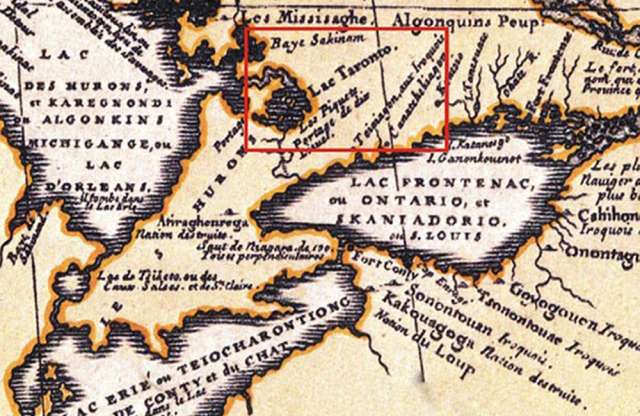
Detail from a 1688 map of western New France by Vincenzo Coronelli that locates “Lac Taronto” at Lake Simcoe.
City of Toronto Culture Division/Library and Archives Canada via the National Post
… within all that the accurate answer to “Whose land are we on?” is the land of the latest bunch of murderous bastards who killed all the previous inhabitants. Perhaps moderated to say the peeps who killed all the previous men then dated the remaining womenfolk. Because once we’ve got past that nullius stage that’s the way it has been. The Moriori are in short supply these days on the Chatham Islands given that the Maori decided to eat them.
The original inhabitants of the British Isles, the Beaker Folk, were entirely replaced by the next lot, the Iron Age Celts and similar. The Angles displaced to the west the Romano Celts in their turn, detailed DNA studies showing rather more of the female side of the R-C’s bred into the new population than the male. The Franks weren’t indigenous to France, the Allemani to Germany, the Turks to Turkey.
In fact, we’ve between little and no proof that the varied Amerinds were the original inhabitants of the lands where the White Europeans found then from 1492 onwards. In the case of both the Incas and Aztecs as political powers, proof they weren’t. And horses and Plains Indians simply weren’t a thing until the Eurasian horse was introduced post 1492.
Basically, this is indeed true. Anywhere is the possession of simply the last group of people to have slaughtered, or outbred, the previous group.
An interesting observation – if we apply the oft stated Americas example elsewhere, that Whitey stole it all and should give it back, then the Bantu should be back in Nigeria and Central Africa returned to the Pygmies, Southern to the Khoi San. We don’t say that and for the life of me I can’t work out why.
April 29, 2019
Banning single-use plastics won’t make much (if any) difference
My local high school is suddenly all about the proposed ban on single-use plastics — where student-made posters used to proclaim their dedication to gender equality, they’re now all about the evils of plastics. It’s almost like it’s a co-ordinated campaign that originated somewhere else…
But despite the students’ new-found environmental awareness, the ban they favour would make little or no difference to plastic items ending up in the oceans, because the vast majority of the plastic there comes from only ten rivers, none of them in North America (this is from a World Economic Forum report). Jason Unrau reports on his trip up the Yangtze River in China twenty years ago that illustrates the breadth of the problem:
Beginning in Shanghai in the summer of 1999, I boarded a large flat-bottom boat with around 300 other passengers. It would be the first of about a dozen different vessels, that over two weeks ferried me 2500 kilometres to Chongqing.
After taking my first meal in the ferry’s mess hall, served in a Styrofoam box, I searched everywhere for a garbage can. There were none – passengers simply tossed their garbage overboard and without an alternative, I joined in the littering.
The banks of the Yangtze are home to more than 200 million Chinese who treat the waterway as commuter corridor and as I soon discovered, a dump. I took the trip to get a glimpse the fabled Three Gorges, before a hydro-electric project and dam would change the watershed forever. As my trip progressed, however, so did my treatment of this historic river as trash receptacle.
The closer I got to Chongqing, the narrower the river became and the smaller the ferries got. About 10 days into the trip, I exited the dining hall of a different vessel to engage in the daily ritual of reckless Styrofoam abandonment, but to my surprise there was a garbage bin.
Delighted at the prospect that my littering ways on the Yangtze were through, enthusiastically I added my box to a near overflowing bin. As if on cue a kitchenhand exited the dining hall, gathered up the bag and heaved the entire thing overboard.
Like I experienced and begrudgingly participated in creating, the World Economic Forum’s report describes “rivers of plastic” – its analyses of respective outputs and comparisons to garbage island and other samples, could be traced back to their source.
According to the economic forum eight of these rivers are in Asia: the Yangtze; Indus; Yellow; Hai He; Ganges; Pearl; Amur; Mekong; and two in Africa – the Nile and the Niger.
December 7, 2018
“A date that will live in infamy” – Speech
FootageArchive – Videos From The Past
Published on 19 Mar 2015Welcome to FootageArchive! On this channel you’ll find historic and educational videos from the 1900s. Watch, learn, and take a trip back in time as we gain insight into a previous time. Subscribe for more.
Note: this video contains archived public domain / licensed footage. This footage serves documentary purposes on world history and is to be viewed as educational.
September 15, 2018
Battle of Saipan – Suicide Island – Extra History – #2
Extra Credits
Published on 13 Sep 2018This series is brought to you by World of Tanks PC. Check out the game at the link below and use the invite code FORAGER for extra goodies. https://redir.wargaming.net/r06pve1j/…
As the ruthless clash of the Saipan invasion drags on into the second week, a unique and unlikely hero emerges. Marine scout Guy Gabaldon can speak Japanese. He deserts his post, not once but twice, to reach out to the enemy soldiers and civilians.
September 8, 2018
Battle of Saipan – Steel and Coral – Extra History – #1
Extra Credits
Published on 6 Sep 2018The battle of Saipan would decide the fate of the Pacific War. On a tiny island, just five miles wide, thousands died under advanced artillery and amphibious tanks. This series is brought to you by World of Tanks PC. Check out the game at the link below and use the invite code FORAGER for extra goodies. https://redir.wargaming.net/r06pve1j/…
Support us on Patreon! http://bit.ly/EHPatreon
August 27, 2018
Kingdom of Majapahit – An Empire of Water – Extra History – #1
Extra Credits
Published on 25 Aug 2018In this series we will explore the history of a short-lived kingdom that united the diverse, 13,000+ islands of Indonesia: Majapahit. Before Majapahit came along, however, the Kingdom of Srivijaya and the Kingdom of Mataram laid the stepping stones.
Please note: The next episode of Majapahit will be published on September 15 and will continue every Saturday thereafter. The EC team is taking a well-deserved short upload break for a few weeks!
July 12, 2018
Great Blunders of WWII: Japan’s Mistakes at Midway
Anthony Coleman
Published on 3 Nov 2016From the History Channel DVD series “Great Blunders of WWII”
April 13, 2018
India and the “Quad”
At Strategy Page, Austin Bay discusses India’s position, both geographically and militarily with respect to China:
As the Cold War faded, a cool aloofness continued to guide India’s defense and foreign policies. Indian military forces would occasionally exercise with Singaporean and Australian units — they’d been British colonies, too. Indian ultra-nationalists still rail about British colonialism, but the Aussies had fought shoulder to shoulder with Indians in North Africa, Italy, the Pacific and Southeast Asia, and suffered mistreatment by London toffs. Business deals with America and Japan? Sign the contracts. However, in defense agreements, New Delhi distanced itself from Washington and Tokyo.
The Nixon Administration’s decision to support Pakistan in the 1971 Indo-Pakistani War [Wikipedia link] embittered India. Other issues hampered the U.S.-India relationship. Indian left-wing parties insisted their country was a “Third World leader” and America was hegemonic, et cetera.
However, in the last 12 to 15 years, India’s assessments of its security threats have changed demonstrably, and China’s expanding power and demonstrated willingness to use that power to acquire influence and territory are by far the biggest factors affecting India’s shift.
In 2007, The Quad (Quadrilateral Security Dialogue), at the behest of Japan, held its first informal meeting. The Quad’s membership roll sends a diplomatic message: Japan, Australia, America and India. Japan pointed out all four nations regarded China as disruptive actor in the Indo-Pacific; they had common interests. Delhi downplayed the meeting, attempting to avoid the appearance of actively “countering China.”
No more. The Quad nations now conduct naval exercises and sometimes include a quint, Singapore.
The 2016 Hague Arbitration Court decision provided the clearest indication of Chinese strategic belligerence. In 2012, Beijing claimed 85 percent of the South China Sea’s 3.5 million square kilometers. The Philippines went to court. The Hague tribunal, relying on the UN Convention on the Law of the Sea treaty, supported the Filipino position that China had seized sea features and islets and stolen resources. Beijing ignored the verdict and still refuses to explain how its claims meet UNCLOS [Wikipedia link] requirements.
That is the maritime action. India and China also have mountain issues. In 1962, as the Cuban Missile Crisis diverted world attention, the two Asian giants fought the Indo-Chinese War [Wikipedia link] in the Himalayas. China won. The defeat still riles India.
“…it is possible to complete an entire degree in anthropology without hearing any criticism of Margaret Mead’s Coming of Age in Samoa“
Margaret Mead’s reputation has run the gamut over the last nearly 100 years after her career-making visit to Samoa in the mid-1920s:
… my journey did leave me with a newfound and abiding respect for the anthropologist Margaret Mead. At the same young age of 23, Mead travelled to the Samoan Islands to the east of the Vanuatu in the South Pacific Ocean to study the islands’ Polynesian people. On a cloudy Samoan day in August of 1925, she stepped off the S.S. Sonoma in Pago Pago Bay, Tuttuila, and began her research. By the end of her career, she was celebrated as the mother of anthropology, both revered and despised for the image of humanity she presented to the world, and for her conclusions about the Samoan people, in particular.
At first, her conversations with the Samoans did not go especially well:
Mead: When a chief’s son is tattooed they build a special house, don’t they?
Asuegi: No, no special house.
Mead: Are you sure they never build a house?
Asuegi: Yes. Well, sometimes they build a small house of sticks and leaves.
Mead: Was that house sacred?
Asuegi: No, not sacred.
Mead: Could you take food into it?
Asuegi: Oh no. That was forbidden.
Mead: Smoke in there?
Asuegi: Oh no, very sacred.
Mead: Could anybody go into the house who wished?
Asuegi: Yes, anybody.
Mead: No one was forbidden to go in?
Asuegi: No.
Mead: Could the boy’s sister go in?
Asuegi: Oh no. That was forbidden.Mead later recalled that she could have “screamed with impatience.” To make matters worse, the native Samoans would often take her belongings and redistribute them according to ceremonial obligations. But, eventually, she began to make progress. Mead developed close friendships with a small and dedicated group of young girls who became her chief informants. She was made a taupou, a ceremonial virgin, despite having a husband back in the United States. Before long, Mead was considered a respected honorary member of the society, and her research project blossomed. A few months and a tropical hurricane later, Mead returned to the United States, and in 1928, she published the results of her research, Coming of Age in Samoa: A Psychological Study of Primitive Youth for Western Civilization.
Her work was widely accepted and praised but by the 1960s, there were some signs challenging her research and conclusions, especially the research of New Zealand anthropologist Derek Freeman. Although he held back the publication of his work until after her death, she was aware of his criticisms and received one of the chapters of his book in advance:
Countless readers had formed a romantic image of the Samoan people from Coming Of Age in Samoa, but now Freeman had broken the spell. The people most blindsided by Freeman’s book were those anthropologists who had stood in front of lecture audiences and fed students Mead’s image of Samoa. Some of them immediately attacked the book. Anthropologist Laura Nader, sister of independent US politician Ralph Nader, called Freeman’s book a “Right-wing political backlash” for questioning the influence of culture on human behavior, and a vote by American Anthropological Association condemned the book as unscientific.
Over the next few decades, Mead’s reputation hung precariously in the balance as anthropologists and evolutionary psychologists battled it out in the nature-nurture controversy. However, the cruelest blow to Mead would come from anthropologists themselves.
It turned out that the young girls Mead apparently depended upon for many of her concepts about Samoan life were far from truthful about their lives:
Unlike the American anthropologists who preached Mead’s findings, Samoans themselves tended to look upon Mead’s work negatively. Some of the Samoan elders burned copies of Coming of Age in Samoa when they realized what Mead had written, and for some time libraries in Samoa didn’t stock the book. Samoan anthropologist Unasa L. F. Va’a called it “one of the worst books of the twentieth century.”3 One of the questions that preoccupied Freeman was how Mead arrived at the erroneous conclusions she drew in her book. He decided that Mead’s own research came mostly from interviews with women, particularly young women, who are hardly the best informants when it comes to matters of historical warfare and violence. On the subject of promiscuity, Freeman conjectured that Mead was the victim of a hoax by her young female informants: “All the indications are that the young Margaret Mead was, as a kind of joke, deliberately misled by her adolescent informants.” In 1987, a few years after Margaret Mead and Samoa was published, it was discovered that one of Mead’s close informers in 1926, Fa’apua’a Fa’amu, was still alive, and wished to swear on the Bible to clear the record on what she had told Mead all those years ago about sexual relations among the Samoans:
We said that we were out all night with the boys; she failed to realize that we were just joking and must have been taken in by our pretenses… She must have taken it seriously but I was only joking. As you know, Samoan girls are terrific liars when it comes to joking. But Margaret accepted our trumped up stories as though they were true.…Yes, we just lied and lied to her.
But was she totally wrong? Doubts exist here, too:
Although Mead’s analysis is obviously highly questionable, the degree to which her work misrepresented Samoan society remains an open question. In 2009, the anthropologist Paul Shankman published his book The Trashing of Margaret Mead in which he reconsiders the evidence. Shankman describes Freeman as an unruly character marked by mental instability, a vindictive desire to ruin the careers of other anthropologists, and plain rudeness (Shankman recalled a nightmare experience when he gave a lecture at ANU and Freeman sat behind him opening and reading his mail so loudly that Shankman had to ask him to stop). This ad hominem attack on Freeman might seem like a desperate effort to evade his refutation of Mead, or to seek revenge on Freeman, but Shankman does succeed in raising some important questions. For example, although virginity is prized in Samoa, it is much more prized among the taupou, the ceremonial virgins of higher status who go on to marry the chiefs. Among the lower status girls, sexual mores were more relaxed and some of these girls did sleep with men before marriage as even Freeman’s data found. Other aspects of Shankman’s belated defense of Mead are more contentious. For example he dismisses Fa’apua’a Fa’amu’s testimony about lying to Mead as irrelevant due to her advanced age and sometimes contradictory statements. He also speculates that Fa’apua’a Fa’amu’s testimony was probably not influential on Mead’s wider conclusions because she was only one of 25 informants. These are important qualifications to what is often presented as Freeman’s decisive refutation of Mead’s work.


